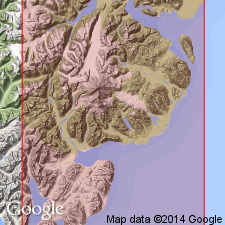
- Usage in publication:
-
- Portage Creek Agglomerate Member*
- Modifications:
-
- Named
- Dominant lithology:
-
- Volcaniclastics
- Tuff
- AAPG geologic province:
-
- Alaska Southwestern region
Summary:
Pg. 14-18, pls. Portage Creek Agglomerate Member, middle member (of 3) of Talkeetna Formation. Exposed in northeastward-trending belt in Chigmit Mountains. Is in fault contact with the underlying Marsh Creek Member (new), and is commonly in fault contact with the overlying Horn Mountain Tuff Member (new), all of Talkeetna Formation. Composed mainly of fragmental volcanic ejecta somewhat similar to that of the Marsh Creek, the main difference being in the form and color of the ejecta. In this member the fragments are mostly rounded volcanic bomb-type detritus, and form massive beds of agglomerate and lapilli tuff having an overall red or pink color. Thickness believed to be between about 2,250 feet and 2,850 feet. Age is Early Jurassic based on stratigraphic relations.
Type section: on south shore of Tuxedni Bay. Section starts about 2.4 mi northwest of Fossil Point and continues along shoreline to contact with underlying Marsh Creek Member. Named from Portage Creek on Iniskin Peninsula, southwestern AK.
Source: US geologic names lexicon (USGS Bull. 1350, p. 592-593); supplemental information from GNU records (USGS DDS-6; Menlo GNULEX).
For more information, please contact Nancy Stamm, Geologic Names Committee Secretary.
Asterisk (*) indicates published by U.S. Geological Survey authors.
"No current usage" (†) implies that a name has been abandoned or has fallen into disuse. Former usage and, if known, replacement name given in parentheses ( ).
Slash (/) indicates name conflicts with nomenclatural guidelines (CSN, 1933; ACSN, 1961, 1970; NACSN, 1983, 2005, 2021). May be explained within brackets ([ ]).

